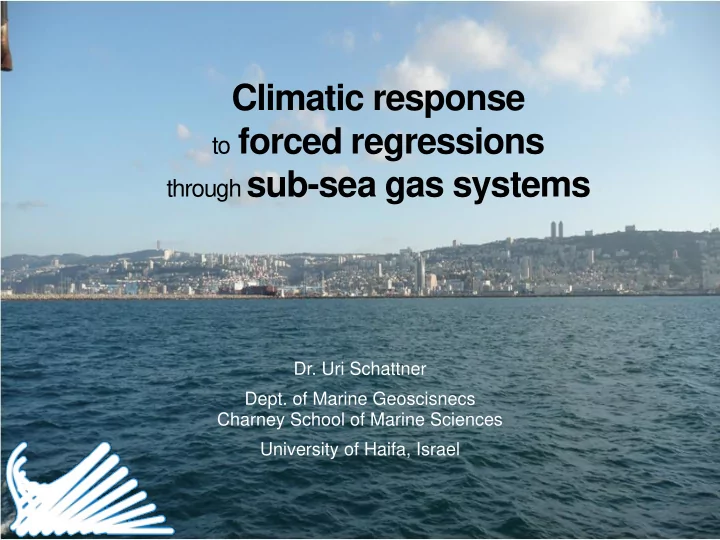

Climatic response to forced regressions through sub-sea gas systems Dr. Uri Schattner Dept. of Marine Geoscisnecs Charney School of Marine Sciences University of Haifa, Israel
Posamentier and Morris, 2000
Climatic response to forced regressions through sub-sea gas systems
2010 2012 2012
R/V Shikmona Thanks to Giora Boxer John K. Hall Barak Herut Revital bookman Gal Hartman Ronnie Sade Orna Buch Arik Golan R/V Eziona DMG students Gideon Amit Support and funding: Charney School of Marine Sciences Margaret Kendrick Blodgett Foundation Paradigm Geophysical, Kingdom Suite, Schlumberger Petrel, ILDC and Modi ’ in Energy and GGR
Multi-channel section – gas chimney Seismic attribute analysis: Seafloor Amplitude Similarity Schattner and Lazar, 2009
Backscatter suspected pockmarks Pockmarks? After Sade et al., 2006
Bathymetry suspected pockmarks ? 1000 m After Sade et al., 2006
Data 5 VHR new surveys 4 MCS available surveys After Sade et al., 2006 After Schattner et al., 2006 Schattner et al., 2010
Single channel survey configuration Hydrophone 6.3 m 0.3 m Sparker 3.0 m 4.6 m 1.6 m 0.9 m 30.0 m 0.6 m 1.2 m GeoSpark 200 sparker by GeoResources Sparker Hydrophone 0.9 m 7.2 m 37.4 m 37.4 m
Data types Schattner et al., 2010
Gas seeps – at ~75m depth Schattner et al., 2012
Low cohesion – at ~35m depth Schattner et al., 2012
Low cohesion Schattner et al., 2012
Findings Seafloor 720 suspected pockmarks Active seeps – 3 consecutive years Low cohesion zone Subsurface Bright spots Gas masking Gas front - ~72 km 2
Widespread indications for cold seeps Schattner and Lazar, 2009
Gas signature Climatic implications Reservoir / emission Permeability Path Lithology + conditions Source
Schattner et al., 2012 Gas chimney 2 major unconformities
Schattner et al., 2012 Gas chimney 2 major unconformities
Mid Pleistocene unconformity Qishon Yam 1 Mid Pleistocene unconformity m Shallow neritic Two way time (Msec) Pleistocene Depth (m) Shelf Shallow neritic Plio-Pleistocene Pliocene m Senonian-Miocene 250 m Well interpretation – Derin, 2002 Harari, 2010, MSc
Correlation between seismic markers – unconformities and sea level Mid Pleistocene transition Relative sea level (m) Time (1000xyears BP) After Paillard, 2006; Lisiecki and Raymo, 2005 Two way time (Msec) 1 km Harari, 2010, MSc
Gas emission response to sea level change Sea level drop Wetland formation Possible Exposure source for organic matter Drainage channels Likely Channel incision correlation to glacial maxima Rapid channel fill Burial of organic rich sediments
Gas emission response to sea level change Removal of Gas Warming release hydrostati c pressure Sea level drop Sea level rise (highstand) Seepage burial under water and sediments Relative sea level Seepage to atmosphere stops Negligible warming effect Lambeck and Chappell, 2001
Exposure during LGM Schattner et al., 2010
LGM negative climate feedback The active gas system -- not unique to offshore Israel It represents the usually underestimated marine methane contribution from mid-latitude continental shelves into sea water and maybe into the atmosphere. Global warming and sea level rise induces a negative, restraining feedback for gas emission across mid- latitude continental margins
Data 2D seismic reflection – time migrated 3D seismic reflection – pre-stack depth migrated Lazar, Schattner and Reshef, 2012
WNW ESE Lazar, Schattner and Reshef, 2012
Giant pockmark Formed on Messinian seafloor Lazar, Schattner and Reshef, 2012
Lazar, Schattner and Reshef, 2012
Base Messinian Lazar, Schattner and Reshef, 2012
Base Messinian over Jonah structure
Lazar, Schattner and Reshef, 2012
Top Messinian Lazar, Schattner and Reshef, 2012
Top Messinian Lazar, Schattner and Reshef, 2012
Mid-Messinian climatic shift Rouchy and Caruso, 2006
Climate is not the direct cause of the Mediterranean desiccation
Climate feedback Tectonic forces Messinian Salinity Crisis Isolation of Mediterranean Massive drop in sea level Exposure of seafloor Spontaneous gas emission Emission of gas to shallow sea and Warming atmosphere Mid-Messinian climatic shift Increased runoff from Gas seepage land areas Terrigenous sediment continues as + supply + increased long as sea channel incision level is low Tectonic opening of Covers Gibraltar Major flood seafloor with water and sediments Stops emission to atmosphere
Conclusions Continental shelf – gas system active today Basin – Messinian gas emission Widespread seepage Negative climatic feedback cycles Shelf – LGM Basin – Mid Messinian climatic shift Climatic response to forced regressions through sub-sea gas systems
Thank you
Recommend
More recommend